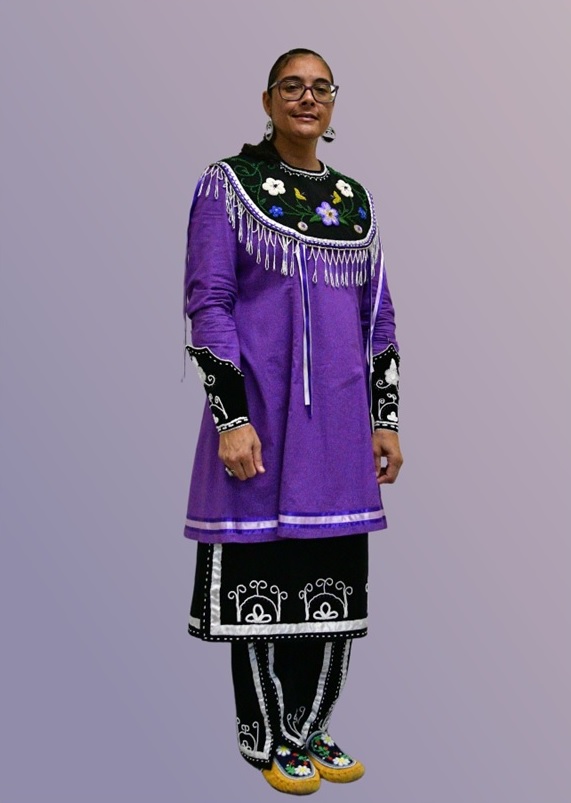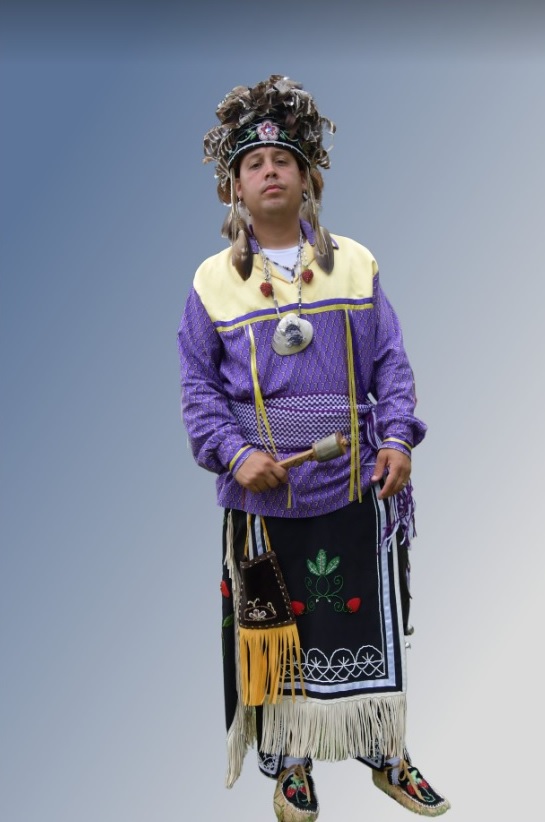
Woman’s Regalia
The Meherrin women’s regalia is a reflection of their culture, beliefs, and traditional practices. It typically includes an Iroquois Ribbon Dress, a Yoke, Raised beadwork cuffs, leggings, and moccasins.
The Iroquois Ribbon Dress is a long dress made from colorful ribbons sewn onto a cotton or linen fabric. The ribbons are arranged in a specific pattern, often with a symbolic design in the center. The dress is an important symbol of the wearer’s cultural identity, and is often passed down from generation to generation.
The Yoke is a decorative collar worn around the neck, typically made from leather or cloth and decorated with beads, quills, or other materials. It is worn over the Ribbon Dress and is often adorned with intricate designs that reflect the wearer’s clan or tribe.
Raised beadwork cuffs are ornate bands of beadwork that are worn around the wrists, often made using a technique known as “raised beadwork.” The cuffs are usually decorated with intricate designs and are considered a symbol of the wearer’s skill and artistry.
Leggings are an essential part of the Iroquois women’s regalia, providing protection for the legs while also serving as a canvas for decorative beadwork or ribbon. The leggings are typically made from soft leather or other durable materials, and are often adorned with intricate designs that reflect the wearer’s clan or tribe.
Moccasins are a type of footwear traditionally worn by the Iroquois women. They are made from soft leather or other materials and are designed to be comfortable and durable. The moccasins are often decorated with beadwork or other designs, and are considered a symbol of the wearer’s connection to the natural world and their cultural heritage.

Men’s Regalia
The Meherrin people have a rich cultural heritage and their traditional clothing reflects their unique identity. The men’s regalia of the Meherrin Tribe typically consists of a ribbon shirt, leggings, breechcloth, finger-woven sashes, and moccasins. In addition, a headdress called Gustoweh is also an important part of their regalia.
The Gustoweh is a traditional Iroquois headdress made from a ash frame wrapped in deer hide with hawk or turkey feathers tied to it.
The ribbon shirt is an important part of the Iroquois men’s regalia, made from colorful ribbons sewn onto a cotton or linen shirt. The ribbons are arranged in a specific pattern.
Leggings are a type of clothing worn on the legs, covering the lower part of the leg from the ankle to the knee. They are typically made of leather or other durable materials and are often decorated with beadwork or other designs. The leggings are worn to protect the legs from scratches and injuries while walking in the forest or hunting. Modern style pants are commonly worm in place of traditional leggings.
The breechcloth is a piece of clothing worn around the waist, covering the front and back of the body. It is usually made from a strip of cloth or leather, and can be decorated with fringe or other designs.
The finger-woven sash is a long strip of woven fabric that is worn around the waist or across the shoulder. It is made using a finger weaving technique, where threads are woven together using the fingers to create a colorful, patterned fabric. The sash is often decorated with beadwork or other designs and is considered a symbol of the wearer’s skill and craftsmanship.
Moccasins are a type of footwear traditionally worn by the Iroquois people. They are made from soft leather or other materials and are designed to be comfortable and durable. The moccasins are often decorated with beadwork or other designs.
Accessories
There are several accessories that are commonly worn with Iroquois regalia, including:
Jewelry: Jewelry is an important accessory in Iroquois regalia and can include necklaces, earrings, nose rings, bracelets, armbands, and rings. Iroquois jewelry is often made from materials such as wampum beads, bone, quills, silver, and copper.
Breastplates: Breastplates made from bone, shell, or horn were worn by men and women as symbols of their status and bravery.
Hair ornaments: Hair ornaments such as feathers, beads, and ribbons are often worn in conjunction with traditional Iroquois hairstyles.
Headbands: Headbands made from ribbon, fur, or beadwork were commonly worn by both men and women.
Tobacco pouches: Tobacco is considered a sacred plant in Iroquois culture, and tobacco pouches are often worn as part of regalia to hold offerings or as a symbol of respect for the plant.
Bags: Leather bags are often worn as part of Iroquois regalia, and are used to hold items such as medicines, personal belongings, and offerings for ceremonies.
Fans: Feather or ribbon fans are used in traditional Iroquois ceremonies and are often carried as part of regalia.
Rattles: Rattles made from gourds or turtle shells were used in Iroquois ceremonies and were often attached to regalia
Bells: Bells are sometimes attached to clothing or regalia to create a jingling sound, which is considered to be pleasing to the spirits.
Garters: Garters were worn by both men and women to hold up their leggings and to add decoration to their clothing. They were sometimes adorned with deer toes which acted as rattles.
These accessories are important elements of Iroquois regalia and are often chosen for their cultural and spiritual significance. They serve to enhance the beauty and symbolism of the regalia and help to express the wearer’s connection to their cultural heritage and spiritual beliefs.
Men’s Regalia 1700’s
The introduction of European clothing had a significant impact on the clothing styles of Native American communities on the East Coast. European traders brought with them a variety of textiles and clothing items that were highly valued by the indigenous peoples, including woolen blankets, cotton shirts, and jackets.
Over time, many Native Americans began to adopt European-style clothing as their own, blending elements of it with their traditional dress. For example, they might wear a European-style shirt with traditional leggings or moccasins, or incorporate European fabrics into their traditional dresses or skirts.
In addition the the Ribbon Shirt previously mentioned, the common style of shirt worn during the 1700’s was the Colonial trade shirt.
Colonial trade shirts were a specific type of European-style shirt that became popular among Native American communities on the East Coast during the colonial period. These shirts were typically made from lightweight cotton or linen and featured long sleeves, a collar, and a button-front closure.
One of the key features of colonial trade shirts was their long length, which extended below the waist and provided more coverage than traditional European shirts. This was likely a response to Native American preferences for longer garments that could be tucked into leggings or breechcloths.
Colonial trade shirts were also notable for their simplicity and lack of adornment. Unlike many European shirts of the time, which featured elaborate embroidery or lacework, colonial trade shirts were typically plain and unadorned. This simplicity made them more versatile and easier to customize with Native American decoration, such as beadwork or quillwork.
Although colonial trade shirts were originally designed for European traders, they quickly became popular among Native American communities on the East Coast. They were lightweight, durable, and provided more coverage than traditional Native American garments, making them well-suited to the region’s hot and humid climate.
Over time, colonial trade shirts became an important element of Native American clothing styles, and many communities developed their own unique variations of the shirt. Today, they continue to be worn by many Native Americans as a symbol of cultural identity and connection to their history.
